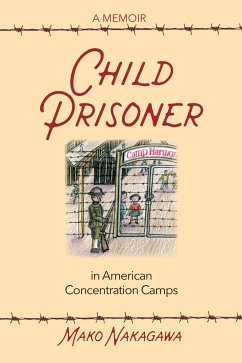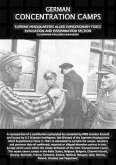15,99 €
inkl. MwSt.
Versandfertig in über 4 Wochen

8 °P sammeln
- Broschiertes Buch
- Merkliste
- Auf die Merkliste
- Bewerten Bewerten
- Teilen
- Produkt teilen
- Produkterinnerung
- Produkterinnerung
A memoir of a Japanese American girl imprisoned in U.S. camps during WW II and her insights as an adult making sense of this grave injustice.
Andere Kunden interessierten sich auch für
![American Prisoner of War Camps in Idaho and Utah American Prisoner of War Camps in Idaho and Utah]() Kathy KirkpatrickAmerican Prisoner of War Camps in Idaho and Utah19,99 €
Kathy KirkpatrickAmerican Prisoner of War Camps in Idaho and Utah19,99 €![American Prisoner of War Camps in Washington and Oregon American Prisoner of War Camps in Washington and Oregon]() Kathy KirkpatrickAmerican Prisoner of War Camps in Washington and Oregon20,99 €
Kathy KirkpatrickAmerican Prisoner of War Camps in Washington and Oregon20,99 €![American Prisoner of War Camps in Montana and Wyoming American Prisoner of War Camps in Montana and Wyoming]() Kathy KirkpatrickAmerican Prisoner of War Camps in Montana and Wyoming20,99 €
Kathy KirkpatrickAmerican Prisoner of War Camps in Montana and Wyoming20,99 €![American Prisoner of War Camps in Northern California American Prisoner of War Camps in Northern California]() Kathy KirkpatrickAmerican Prisoner of War Camps in Northern California20,99 €
Kathy KirkpatrickAmerican Prisoner of War Camps in Northern California20,99 €![American Prisoner of War Camps in Arizona and Nevada American Prisoner of War Camps in Arizona and Nevada]() Kathy KirkpatrickAmerican Prisoner of War Camps in Arizona and Nevada19,99 €
Kathy KirkpatrickAmerican Prisoner of War Camps in Arizona and Nevada19,99 €![American Prisoner of War Camps in Southern California American Prisoner of War Camps in Southern California]() Kathy KirkpatrickAmerican Prisoner of War Camps in Southern California20,99 €
Kathy KirkpatrickAmerican Prisoner of War Camps in Southern California20,99 €![German Concentration Camps German Concentration Camps]() G-2 Counter Intelligence Sub-DivisionGerman Concentration Camps17,99 €
G-2 Counter Intelligence Sub-DivisionGerman Concentration Camps17,99 €-
-
-
A memoir of a Japanese American girl imprisoned in U.S. camps during WW II and her insights as an adult making sense of this grave injustice.
Produktdetails
- Produktdetails
- Verlag: NewSage Press
- Seitenzahl: 270
- Altersempfehlung: ab 12 Jahre
- Erscheinungstermin: 17. März 2019
- Englisch
- Abmessung: 226mm x 152mm x 15mm
- Gewicht: 363g
- ISBN-13: 9780939165742
- ISBN-10: 0939165740
- Artikelnr.: 53688024
- Verlag: NewSage Press
- Seitenzahl: 270
- Altersempfehlung: ab 12 Jahre
- Erscheinungstermin: 17. März 2019
- Englisch
- Abmessung: 226mm x 152mm x 15mm
- Gewicht: 363g
- ISBN-13: 9780939165742
- ISBN-10: 0939165740
- Artikelnr.: 53688024
In February 2018, Mako Nakagawa celebrated her 81st birthday and completed her memoir, Child Prisoner in American Prison Camps, which she had been working on for more than a decade. This book is based on her original manuscript of stories for young readers, Camp Child, self-published in 2007. Her brother-in-law, Mits Katayama, a well-established commercial artist, created original illustrations to accompany Mako's stories. Mako began her formal education at five years old as a child prisoner in American concentration camps built to confine people of Japanese ancestry living on the West Coast during World War II. In her adult years, Mako became an educator, earning her M.A. in Education from Seattle University. She specialized in multicultural education and was the Program Director for Seattle Public School's Ethnic Cultural Heritage Program (RAINBOW). In 1976, she oversaw development of a RAINBOW curriculum for a national market and received a Washington Education Association Curriculum Award in 1977 for her work on this project. Mako served as principal at two Seattle elementary schools in the 1970s and 1980s. She went on to become Program Administrator for Multicultural Education, Basic Skills and the Curriculum unit of the Washington State Office of the Superintendent of Public Instruction (OSPI). Her growing concern for Japanese American civil rights and redress matched her ongoing concern for multicultural education. In 1991, Mako started her own business, Mako & Associates, providing contract diversity training programs. As an accomplished public speaker and writer, Mako emphasized the "power of words" and the importance of describing the imprisonment of Japanese Americans with accurate terminology - not with euphemisms that mislead and distort the truth. Mako was an active member of the Japanese American Citizens League (JACL) and other groups to create policies and plans to educate the general public about the injustices in recent U.S. history, in particular, the imprisonment of 120,000 people of Japanese ancestry living on the West Coast. Over the years she has made numerous presentations on her experiences as a child prisoner and conducted a series of workshops on the subject for teachers, organizations, and students from elementary through college. Mako has been the recipient of numerous awards and honors for her work as an educator, including from the national Committee on School Desegregation, the Asian Education Advisory Council, and the Japanese American Citizens League. Mako lives in Seattle and has three adult children. She enjoys Seattle sports including the Seahawks, Sounders, and Mariners, and spending time with her family and friends. This is her first published book and if you ask her -her last! Mits Katayama was a well-established and talented artist of renown in his profession as a commercial artist. He was recognized over the course of his life with a number of honors and awards as an artist and as a caring community activist. Mits illustrated a number of children's books for Parenting Press, including What About Me? 12 Ways to Get Your Parents' Attention (Without Hitting Your Sister) and Feelings for Little Children Series, among others. Mits began drawing as a boy and spent most of his adult life drawing and painting primarily as a commercial artist. He credited his first-generation Issei parents, along with a teacher in his small three-room rural school, for encouraging him early along. Mits was incarcerated at Minidoka concentration camp in 1942 as a young teen and spent three years there with his family. At the time, he was living with his widowed mother and a younger brother in a small rural area south of Seattle. Mits had many distinct memories from what he called his "camp days" that he drew from in his detailed illustrations for this book. During his imprisonment, Mits became well-known in the community for his singing. His crooning style earned him the title of the "Japanese Frank Sinatra." His public appearances were in stark contrast to his shy personality, but he sang at many weddings, festivals, bazaars, and family gatherings. After the war, Mits returned to Seattle and graduated from Garfield High School and later, the Edison Technical School, now called Seattle Central Community College. He also served in the U.S. Signal Corps as a radio operator-and as an artist assigned to paint names on Army helmets. Mits married Kazu Takahashi (Mako's eldest sister) in Seattle on September 20, 1953. They both had many names. Kazu is Kazzie to friends and Kai to family. Francis Mitsuru was Mits to friends and Yogi to family, inspired by his drawings of Yogi Bear. To both, the names most important have always been Hamma (Grandma) and Bumpa (Grandpa) to Sara. Mits and Kazzie raised there three sons-Mark, Glenn, and Stevan in Seattle. Mits loved to place gold and tennis, to shoot pool, and to watch the Seahawks and Mariners. Mits passed away in November 2014, but his spirit lives on through his art.







